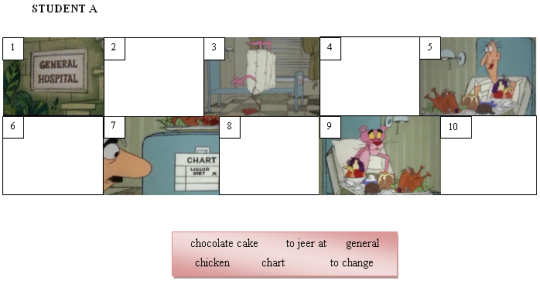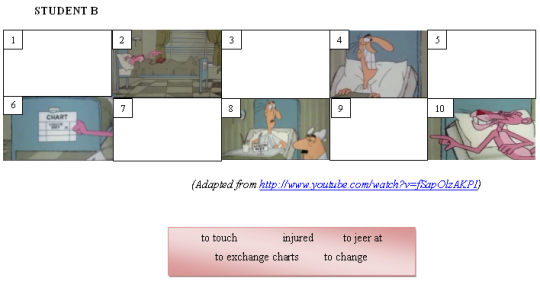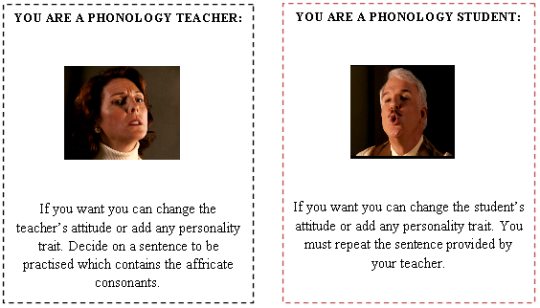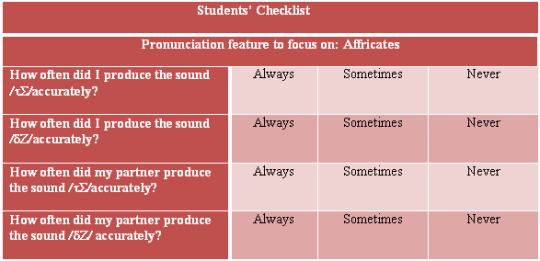Let’s Take a Look at Affricate Sounds with “The Pink Panther”
Bettiana Andrea Blázquez, Argentina
Bettiana Andrea Blázquez has an M.A. in English Language Teaching and Applied Linguistics from King’s College, London University. She is currently working as an assistant in the subjects Elements of Phonetics and Diction, Phonetics and Phonology I and English II at Facultad de Lenguas, Universidad Nacional del Comahue. Her interests include learning strategies, motivation and prosody in spoken English and Spanish.
E-mail: bettianablazquez@hotmail.com
Menu
Introduction
Background
A communicative framework for teaching Ƭ∑ and ∂Z
Teaching Techniques and Activities: Description of the Worksheets
Conclusions
References
Websites
This paper seeks to provide several techniques and activities that can be used to help learners produce affricate sounds, i.e. /Ƭ∑/ and /∂Z/, accurately. The first section of the article details the reasons for focusing on affricates and describes the typical difficulties encountered by learners of English. The second part intends to offer a possible solution to these phonemic learning problems by outlining a communicative framework for sequencing activities in pronunciation instruction. Finally, more practical aspects are covered by describing some techniques and providing a set of worksheets that can be used to polish these two consonants. Practising and producing affricates in certain contexts will eventually lead the learners to use them correctly in other circumstances and real life situations within and beyond the limits of the classroom.
In the production of consonants the airstream meets an obstacle created by the speech organs. The type of obstacle that the airflow encounters determines the way or how consonants are produced. For example the sounds that result from a combination of a stop and a fricative are termed affricates. The two sounds in English known as affricates are /Ƭ∑/ and /∂Z/ which are both palato-alveolar. During their articulation the tip and blade of the tongue (active articulator) rise to articulate with the alveolar ridge and the front of the hard palate (passive articulators) to stop the air-flow. Then the articulators are slightly separated and the air is released through this narrowed passageway like a fricative (Ashby 2005). However, these two consonants differ as to their voicing and force of articulation. While Ƭ∑/ is described as a voiceless fortis sound since its production requires no vibration of the vocal folds and strong muscular effort, /∂Z/ is said to be a voiced lenis consonant as its articulation involves the vibration of the vocal cords but less muscular effort.
The physiological problems involved in getting one’s tongue around /Ƭ∑/ and /∂Z/ are well known (Avery & Ehrlich 1992, Kenworthy 1987). These two foreign sounds demand a deliberate physical effort on the part of French, German and Spanish speakers among others. To take an example, in learning English French speakers find it difficult to produce affricates as they are not part of their inventory of sounds. Germans tend to substitute /Ƭ∑/ and /∂Z/ since they have the former but not the latter. Spanish speakers are unfamiliar with /∂Z/, therefore they may use Ψ instead and they are also likely to produce /∑/ where /Ƭ∑/ should occur (Kenworthy 1987).
Apart from facing physiological problems, learners seem to deal with psychological barriers. They are generally reluctant to move away from the safe ground of known phonemes into alien phonemic territory. Furthermore, they may even have an unsympathetic attitude towards the culture these sounds stand for and they may not want to sound like the native speakers of this target language (Scott 1988). Learners may also feel frustrated especially when having them continually repeat a mispronounced word. Such a negative experience may deteriorate their self-esteem which may consequently affect the ability to produce English sounds.
When dealing with any phonemic learning problem we should take into account both physiological as well as psychological factors. For example the physiological aspect can be covered by seeing and feeling how sounds are articulated and the psychological resistance to new phonemes can be lowered by making learning fun (Scott 1988). Bearing this in mind, the rest of this article attempts to literally show how to deal with these diverse factors which affect the accurate production of affricates by using both varied and motivating tasks that follow a communicative approach.
The framework below outlines a communicative approach for teaching pronunciation following the research line developed by Celce-Murcia, Brinton & Goodwin (1996), Goodwin (2001). They have demonstrated that pronunciation instruction occurs in five stages:
- Description and analysis: The teacher presents a feature showing when and how it occurs. He/she might use charts or might present rules inductively or deductively.
- Listening discrimination: In this phase the main objective is to make learners focus on a feature they might have not recognised yet. Some listening discrimination activities include a transcript with a short listening passage to circle or mark the elements they hear.
The three final stages involve practice and production. They actually progress on a continuum or move forward systematically.
- Controlled practice: This type of practice implies having the students concentrate entirely on the target feature. Poems, rhymes and contextualised dialogues can be used at this stage. Performing dialogues in pairs are a combination of both listening discrimination for one partner and controlled practice for the other.
- Guided practice: In guided activities, the learners’ attention is no longer on form. They now start to pay attention to meaning, grammar as well as pronunciation. Teachers can make use of information gap activities in this stage of the lesson.
- Communicative practice: In this phase, activities keep a balance between form and meaning. Examples include role-plays, interviews, discussions, debates and the like.
The lesson activity sequence outlined in the worksheets at the end of the article intends to show the gradual progression mentioned above. The guided practice activity stands as an example of a slightly less controlled task and it represents a point of departure from the controlled practice in which the learners are asked to read a dialogue aloud. Once the learners have had the chance for controlled and guided practice, they will engage in communicative tasks.
Using a clip
Using a clip in a lesson has proved to cause a relaxing, motivating and funny atmosphere (King 2002). Therefore, this resource seems to be a highly suitable tool for encouraging students to face physiological and psychological barriers. In the worksheets below the point of departure is a scene taken from the film The Pink Panther which was released in 2006. Scene 17 has a total running time of 3 minutes, so it can easily be accommodated at the beginning of the lesson.
The main reason for choosing this scene is that it shows a learning situation in which a French speaker, detective Clouseau, attempts to polish his English with the help of a phonetician. Viewing this pronunciation lesson may help learners establish some connections as well as find similarities and differences with their own learning experience.
Another relevant aspect of this audiovisual text is that it contains rich language that includes most of the characteristics of oral discourse (prosodic features, speed, volume of speech, body language) and paralinguistic features (gestures, facial expression, eye contact, posture) (Massi & Blázquez 2008). The use of these features help to depict all the emotional factors that can typically be involved in a pronunciation lesson (for instance, a learner may feel frustrated when he/she cannot produce a sound accurately, he/she may be strong-willed but the teacher may not be employing adequate techniques to improve his/her pronunciation).
Animated vocal tracts, images and tactile reinforcement
A complementary approach to the teaching of phonemes is to illustrate and discuss how sounds are physically articulated. Visual reinforcement can be used to accomplish this aim. For example, animated vocal tracts or images are useful in demonstrating the manner and the place of articulation of sounds which cannot be seen by looking at the mouth. In the worksheets below, images captured from online animated vocal tracts have been used to illustrate the manner and the place of articulation of /Ƭ∑/ and /∂Z/.
However, it is advisable to use the online animated vocal tracts in the pronunciation lesson since the learning process might be more effective when seeing how the organs actually move. These online animated vocal tracts can be available at:
www.uiowa.edu/~acadtech/phonetics/english/frameset.html
Apart from using diagrams of the vocal tract, some questions are asked in order to activate the learners’ previous knowledge on the descriptive criteria. In doing so, it is important to emphasise that articulation needs to be experienced to be understood (Dalton & Seidlhofer 1994). There is no point in just telling the students that /Ƭ∑/ and /∂Z/ are palato-alveolar affricates they need to see and feel how they are produced to literally put theory into practice and correct inaccurate pronunciation. Therefore, another technique that can be used in pronunciation teaching is tactile reinforcement (Celce-Murcia, Brinton & Goodwin 1996). An example is to give learners tactile descriptions so that they can feel the passive articulators with the tongue. For instance, we can ask our students to move their tongue towards the roof of their mouth. “Can you feel the roof with your tongue? You will feel the alveolar ridge, which is a hard bump, just behind your upper teeth. Then there is a concave surface or depression... that is the beginning of the palate”. Both visual and tactile reinforcement may be provided to cover the description and analysis stage in a communicative approach for teaching pronunciation.
Contextualised dialogues
A popular technique for practising phonemes involves the repetition of minimal pairs. As this method seems to characterise a dull approach to pronunciation instruction, the material employed in the worksheets tries to avoid focusing on isolated words or sentences to practise affricates. In fact, a drill-like activity has been improved to make it more meaningful for the students while still keeping the focus on sounds. For example students are provided with a contextualised dialogue and next to it pictures of inspector Cousteau and the Pink Panther have been added as if they were really having that conversation. The main purpose of doing this is to create a connection between this activity and a central topic so that students can get involved in the pronunciation lesson more easily. This activity implies some practice in recognition of sounds by means of spelling and auditory perception and production. It has been included in order to cover both the listening discrimination and controlled practice stages.
Information-gap activities
Information gap activities are attractive because some of the information is missing and the learners feel tempted to get the part they do not have. Needless to say we can create our own information gap activities bearing in mind our teaching purposes and objectives. A preliminary stage consists of selecting an appropriate short or clip from the Internet. In doing so, it is necessary to make sure that it has a context that can provide words with the target sounds. Then, we need to opt for the images that are relevant in the story and capture them. Finally, we need to choose all the words that contain the target sounds.
The worksheets below include an information gap activity that is made up of several pictures captured from a short called “The Pink Panther at the Hospital” available at www.youtube.com/watch?v=fSapOlzAKPI. These images and the words in the boxes have been carefully selected in order to cue production of particular sentences in the guided practice stage of teaching.
Drama
Accurate pronunciation fluctuates with the degree of confidence a speaker has and to the degree the speaker feels relaxed. In other words, the more self-confident the learner is, the more relaxed he will feel and the more accurate he will pronounce words or phrases. Given that drama has proved to be an effective tool for building up students’ self-confidence (Celce-Murcia, Brinton & Goodwin 1996), a role-play activity or drama exercise has been included in the worksheets. This communicative activity addresses the topic already introduced by the previous tasks, which is “The Pink Panther” and the phonology lesson. Pictures of the main characters of the scene they watched at the beginning of the class (Cousteau and the phonetician) and some guidelines to create a script have been added. The main objective is to practise affricates as well as various components of communicative competence in an integrated way. Therefore, we should not only draw our attention to /Ƭ∑/ and /∂Z/, but also to other features such as discourse intonation, pragmatic awareness, nonverbal communication, etc. After rehearsing, the pairs may be videotaped performing the role-play so that peer feedback can be carried out later on.
Self-monitoring and peer feedback
Feedback during instruction is really important as it gives learners an idea of their progress and what aspects of their pronunciation they need to improve on. Self-monitoring and peer feedback are different ways of providing feedback. The former has to do with developing a sense of self-correction, whereas the latter implies a partner who monitors a student’s performance and perhaps can convince him/her that certain areas of his/her speech need further practice. These techniques minimise dependence on the teacher and maximise self-reliance and autonomy (Avery & Ehrlich 1992).
In the worksheets below, there is a checklist developed into a rating scale. This tool consists in a list of items to record the frequency of the accurate production of affricates. Outside of class, students work in pairs. Each of them has this checklist to review his/her own performance as well as their partners’. They watch the tape as many times as possible in order to monitor for these specific features and fill in the checklists. Finally, they compare and contrast their views on each others’ oral performance.
Real-life situations
The closure activity brings the learners full circle back to the beginning of the lesson, as it consists of some questions to reflect on the “The Pink Panther” scene and their own reality. They have been designed to generate debate while comparing and contrasting the students’ phonology lesson with the one portrayed in the scene. Learners are also expected to reflect on the strategies or techniques that they apply to improve their pronunciation and the attitude they generally adopt when they face difficulties in producing sounds. Addressing a central topic which is connected with the learners’ present allows them to transfer what has been learnt to a real life situation.

|
 LEAD-IN
LEAD-IN
|
 1. a. You are going to watch a short scene taken from the film “The Pink Panther”. In this scene the main character, the French police detective Clouseau tries to improve his pronunciation as he has to travel to New York to interview a witness. Make some predictions: What might happen in this pronunciation lesson? What phonetic features is he going to practise? 1. a. You are going to watch a short scene taken from the film “The Pink Panther”. In this scene the main character, the French police detective Clouseau tries to improve his pronunciation as he has to travel to New York to interview a witness. Make some predictions: What might happen in this pronunciation lesson? What phonetic features is he going to practise?
b. While you watch the clip answer the questions below:
- Do the teacher and the detective change their attitudes along the scene? If so, how do they feel at the beginning and at the end of the lesson? What characteristics of their speech let you answer these questions?
- What techniques or strategies does the phonology teacher employ to help the learner? What techniques or strategies does the student apply to improve his pronunciation?
- What sentence does the man repeat?
- Does this sentence contain any affricate sounds? Mention the affricate consonants.
|
 DESCRIPTION AND ANALYSIS
DESCRIPTION AND ANALYSIS
|
2. Look at the vocal tract diagrams below. What is the place of articulation of /Ƭ∑/ and /∂Z/? How can you distinguish these two sounds? Which diagram corresponds to /Ƭ∑/ and which one corresponds to /∂Z/?

(Adapted from: www.uiowa.edu/~acadtech/phonetics/english/frameset.html)
|
 LISTENING DISCRIMINATION/CONTROLLED PRACTICE
LISTENING DISCRIMINATION/CONTROLLED PRACTICE
|
3. a. The Pink Panther and inspector Clouseau are having a conversation. Read the dialogue below carefully and underline the words that are pronounced with /Ƭ∑/ and /∂Z/. Then listen to check. Which clues do you have in the text as to the connection between spelling and pronunciation?

(Adapted from: Hancock, M. 2003. English Pronunciation in Use. Cambridge: Cambridge University Press).
b. Work in pairs to carry out peer-correction. Take turns to read the dialogue aloud, while the other student corrects the mistakes. Please do not behave as the teacher in the scene!!! Be patient!!!
|
 GUIDED PRACTICE
GUIDED PRACTICE
|
4. Work in pairs again. The pictures below were taken from an animated short called “The Pink Panther at the Hospital”. Some pictures are missing!!! Use the words in the box to retell your part of the story to your partner. Also pay attention to what your partner says to fill in the gaps.


|
 COMMUNICATIVE PRACTICE
COMMUNICATIVE PRACTICE
|
5. Work in pairs. Read the role-cards below and write a short script for a play. Practise it as much as you can at home. Be ready to perform it in class!!! Your performance will be videotaped!!!

|
 CLOSURE
CLOSURE
|
6. Work in groups and discuss the questions below.
- What piece of advice would you give inspector Clouseau if he could not pronounce affricates accurately?
- What strategies do you usually employ when you cannot produce a certain sound?
- What attitude do you have when you cannot pronounce a sound after having practised for hours?
- What have you learnt in this lesson? How have you felt about these activities?
|
 FOLLOW-UP ACTIVITY
FOLLOW-UP ACTIVITY
|
7. Watch your performances and reflect on them. Complete the checklist below. Please provide examples whenever possible.

The tasks in the worksheets above are intended to work as templates that can be modified according to the objectives of a particular phonology lesson. They can serve as springboards for adaptation and further use in other realities and contexts.
In this article the different physiological and psychological problems of learning Ƭ∑ and ∂Z have been addressed. Furthermore in examining the specific problems of these consonants for learners of English it has been demonstrated that, in some cases, the teaching of affricates plays a significant role in communication.
Affricates deserve attention, but also the approach to teach these segmental features. Using meaningful activities organised in a systematic and principled way will certainly lead teachers and learners to get a more efficient learning process. If we use different techniques and motivating tasks, our learners will develop both the confidence to take part in communicative situations with ease, and the ability to automatically monitor their speech and make adjustments whenever necessary.
Avery & Ehrlich (1992). Teaching American English Pronunciation. Oxford: Oxford University Press.
Ashby, P. (2005). Speech Sounds. Oxon: Routledge.
Celce-Murcia, M., D. M. Brinton, & J.M. Goodwin. (1996). Teaching Pronunciation: A reference for teachers of English to speakers of other languages. Cambridge: Cambridge University Press.
King, J. (2002). Using DVD Feature Films in the EFL classroom: In The Weekly Column. Article 88. Available:
www.eltnewsletter.com/back/February2002/art882002.htm
Dalton, C. & B. Seidlhofer. (1994). Pronunciation. Oxford: Oxford University Press.
Goodwin, J. (2001) Teaching Pronunciation, in Celce-Murcia M. Teaching English as a Second or Foreign Language. Boston: Heinle & Heinle.
Hancock, M. (2003). English Pronunciation in Use. Cambridge: Cambridge University Press.
Kenworthy, J. (1987). Teaching English Pronunciation. London: Longman.
Massi, M.P. & Blázquez, B. (2008). Exploiting DVDs’ Extra Features: An Added Bonus in the EFL Class. Humanising Language Teaching. Free Online EFL Magazine for Teachers. Canterbury, UK. Available: old.hltmag.co.uk
Scott, I. (1988). Betty Botter vs. Peter Piper: a plosive encounter. In Modern English Teacher. Volume 15 Number 3.
www.uiowa.edu/~acadtech/phonetics/english/frameset.html
www.youtube.com/watch?v=fSapOlzAKPI

The Pronunciation course can be viewed here


|